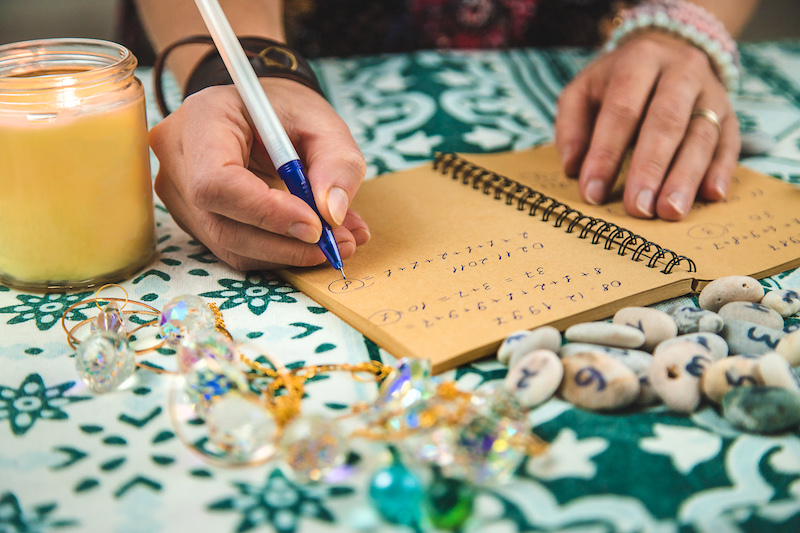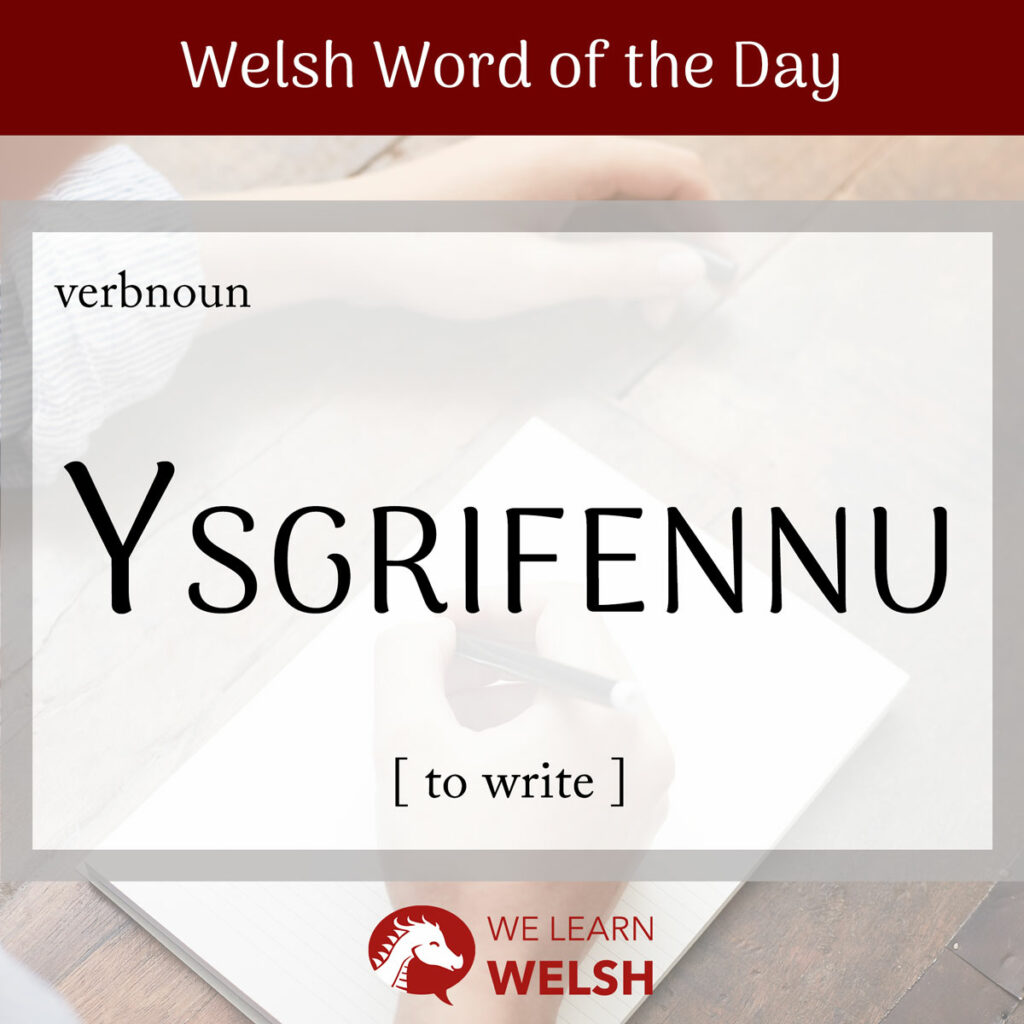Acclaimed Welsh writers throughout the ages have included Hedd Wyn, an incredible Welsh-language poet who was posthumously awarded the great honour of Y Gadair (The Chair), famous children’s author Roald Dahl, who was in fact born and raised in Cardiff, and of course, the iconic Dylan Thomas. The Welsh word for to write is ysgrifennu.
ysgrifennu
to write
Ysgrifennu comes from the proto-Brythonic *iskrivenn, and ultimately from a Latin root, scribō. This is also the ancestor of the English scribe, the Italian scrivere and the French écrire. Because ysgrifennu begins with a vowel, it never undergoes mutation.
It’s very common in speech to shorten ysgrifennu to the simple sgwennu (although sgrifenu is the more usual slang form in the South). Using sgwennu is a quick and easy way to make your Welsh sound natural and casual. On the other hand, if you want to be more formal or to vary your vocabulary mewn sgrifen (in writing), you can use cyfansoddi (compose) or gohebu (communicate).
There are all sorts of things you might need or want to write in your life. Most of us have experienced writing traethodau (essays) at school. This is also where we learn the difference between ysgrifen ffurfiol (formal writing) and ysgrifen anffurfiol (informal writing). You might even get to experiment with ysgrifennu creadigol (creative writing) and if you’re really good at it, you could go on to become an awdur (author) and write nofelau (novels), cerddi (poems) and dramâu (plays).
Mae plant yn dysgu ysgrifennu pan maen nhw’n tua phum mlwydd oed.
Children learn to write when they are about five years old.
Some time ago, people communicated largely by writing llythyron / llythyrau (letters).
In Welsh, you don’t write a letter to someone, you actually write it ‘at’ them. It sounds a bit rude in English! So remember to say ysgrifennu llythyrau at Catrin (writing letters to Catrin) rather than ysgrifennu llythyrau i Catrin, which would be incorrect. You can also simplify this into llythyru â Catrin (exchanging letters with Catrin).
Today, we usually spend more time writing tecsts / negeseuon testun (texts) and negeseuon ebost (emails). This also means usually using a ffôn symudol (mobile phone)or cyfrifiadur (computer) to write, rather than a pen (pen) or pensel (pencil). Sadly, this means that equipment such as the asgell sgrifennu (quill pen) or the slightly more modern peiriant ysgrifennu (typewriter) has largely fallen out of use.

Here’s a few more handy ysgrifennu-related terms to get to grips with:
- llyfr = book
- papur = paper
- ysgrifbin = another, fancier word for pen
- darllen = read
- gair = word
- stori = story
- llên / llenyddiaeth = literature
Welsh also has a special verb, llenydda, which means to write literature.
Dw’isio papur i sgwennu arno.
I want some paper to write on.
As I mentioned earlier, ysgrifen means writing, or handwriting (for the latter you can also say llawysgrifen). My mum tried very hard to get me to develop ysgrifen lân (good/neat handwriting, literally clean handwriting) but unfortunately, to this day I still have ysgrifen afler (untidy handwriting). Cursive handwriting is ysgrifen redeg, which literally means running writing.
A signature is llofnod, but remember: if you’re writing [your] name, this is actually described as torri[’ch] enw. Literally, this means breaking [your] name. Ysgrifennu isn’t used here!
Let’s quickly look over some of the most commonly used conjugations of ysgrifennu.
| Future | Conditional | Past | |
| First person singular | Ysgrifennaf i I will write | Ysgrifennwn i I would write | Ysgrifennais i I wrote |
| First person plural | Ysgrifennwn ni We will write | Ysgrifennen ni We would write | Ysgrifennon ni We wrote |
| Second person singular / informal | Ysgrifenni di You will write | Ysgrifennet ti You would write | Ysgrifennaist ti You wrote |
| Second person plural / formal | Ysgrifennwch chi You will write | Ysgrifennech chi You would write | Ysgrifennoch chi You wrote |
| Third person singular | Ysgrifennith o/e/hi He/she will write | Ysgrifennai fo/fe/hi He/she would write | Ysgrifennodd o/e/hi He/she wrote |
| Third person plural | Ysgrifennan nhw They will write | Ysgrifennen nhw They would write | Ysgrifennon nhw They wrote |
There are more conjugations than this of course – but they are usually only used in literary Welsh. In colloquial Welsh, many conjugations are formed periphrastically.
This means that ysgrifennu stays in the infinitive, and is instead paired with a conjugated form of bod (to be) or gwneud (to do), which conveys the tense of the sentence. Every conjugation of ysgrifennu not listed in the table above is normally formed periphrastically, and many of those that are listed often are, too.
If you want to command someone to write, you can say ysgrifenna or ysgrifennwch. The second is for if you’re speaking more formally, or you’re speaking to more than one person.
Ysgrifennoch chi’r traethawd ardderchog ‘ma?
Did you write this excellent essay?
Although Wales is known for a great literary tradition, especially of barddoniaeth (poetry) and chwedloniaeth (mythology), it was historically actually largely a spoken language. The Welsh language began to develop around 550AD, but written testunau (texts) in Welsh didn’t really surface before the 900s, and even then they featured plenty of borrowings from Latin.
Welsh sillafu (spelling) wasn’t standardised until 1928, which probably explains why it’s so phonetic, with each llythyr (letter) corresponding with the same sound almost every single time. This is great news for new Welsh speakers in a language that is known for being otherwise quite tricky to learn!
Ysgrifennwyd y nofel ‘Rhyfel a Heddwch’ gan awdur o Rwsia.
The novel ‘War and Peace‘ was written by a Russian author.
Today, Welsh speakers use the term cynfeirdd (literally, poets before) to refer to some of the earliest Welsh ysgrifenwyr (writers), such as the famous, semi-mythical poet Taliesin. But Welsh llenyddiaeth really came into its own around the turn of the fifteenth century, when the manuscripts surfaced of what would become the Mabinogion, a collection of weird and wonderful Welsh folktales. Did you know that the Mabinogion is even the origin of the legendary story of King Arthur?
And modern Welsh writing doesn’t disappoint either. Whether it’s English-language authors like Roald Dahl and Philip Pullman, or those keeping the heniaith (old language) strong, such as Mererid Hopwood and Manon Steffan Ros, Wales is definitely a nation that sees the value in stories.
Who’s your favourite Welsh author? Leave a comment down below and let us know.


